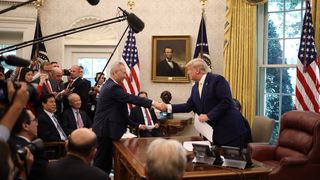The Trump administration’s tentative trade deal with Chinese negotiators is not worth the paper it is not printed on. It is just another instalment in the cycle of stop-start negotiations and tit-for-tat tariffs that has inflicted enormous damage on the US and world economy.
The best that can be said for the prospective deal is that it forestalls the next US tariff increase scheduled for October 15, which would have seen the 25 per cent tariff on $US250 billion ($368 billion) of Chinese imports raised to 30 per cent.
The proposed increase would have taken the average tariff rate on Chinese imports to the US to 23.8 per cent.
However, the planned 15 per cent tariff on another $US160 billion in Chinese imports scheduled for December 15 will still go ahead.
Together, the proposed tariffs would have raised the average tariff rate to nearly 27 per cent, covering nearly 97 per cent of China’s imports.
Even if the proposed agreement makes it onto a signed piece of paper, the average tariff rate will remain at 21 per cent, covering only 69 per cent of Chinese imports.
For its part, China has raised the average tariff rate on US imports to nearly 22 per cent.
In return for the partial stay on tariffs, China will increase its purchases of US agricultural products by $US50 billion. But these purchases were always among the most trivial elements of any deal and have been on the table for months.
It will do little to compensate US farmers, many of whom have been reduced to federal welfare recipients, costing the US Treasury more than it is collecting in tariff revenue.
The currently proposed tariffs are among the biggest tax increases in US history. However, their full force won’t be apparent until after the December 15 tariff hike. US importers have already stockpiled goods ahead of the tariff increase, so the burden on US consumers and business, already substantial, won’t be fully apparent until next year.
The US has also secured the outlines of a currency accord, which will likely borrow from similar provisions in the new US-Mexico-Canada free trade agreement.
Whereas the US previously advocated flexible exchange rates as conducive to free trade, the US will being asking China to manage its exchange rate in US interests.
The US has already designated China a ‘currency manipulator’ for accommodating the market forces pushing its exchange rate against the US dollar lower. But for Chinese intervention to support its currency, the depreciation would have been even more dramatic.
Different views
The US and China will likely take different views on whether China’s exchange rate management is consistent with the deal.
Because the deal is effectively an executive memorandum of understanding, it will have none of the dispute settlement and enforcement mechanisms found in properly negotiated and legislated free trade agreements.
In the absence of these mechanisms, the currency accord and other provisions are likely to occasion future punitive tariffs and retaliation.
The deal includes some progress on strengthening intellectual property protections, but omits a wide range of key issues, most notably China’s state subsidies and state-directed lending to Chinese firms and forced technology transfer.
The US blacklisting of Huawei and other Chinese entities is out of scope. Meanwhile, the US is opening up new fronts in the trade war targeting cross-border capital flows.
The proposed deal will take weeks to turn into an agreed text. The plan to sign it at the APEC summit meeting in Chile in November would seem ambitious. The deal may fall over on the detail between now and then.
Given the 15 months it has taken to reach a trivial ‘phase one’ deal, progress on more substantive issues is going to be tough.
Significant damage to the world economy has already been done. It comes not so much from the direct impact of the tariffs, but the uncertainty they have generated.
That uncertainty has prompted a global capital strike and decline in business investment, including in Australia.
Global manufacturing is in recession and trade volumes are contracting, even before the full effect of tariffs is felt.
The outlook for the US and world economy would have been much better but for Donald Trump’s trade war, even with the Chinese economy slowing.
A fully-fledged and properly legislated accord between the US and China covering the substantive issues between them would take many years to negotiate and implement.
Trump’s preference for an executive agreement, which he calls ‘fast and clean’, means that the US can dispose of any or all of the provisions at Trump’s choosing.
The Trump administration has indicated that tariffs will remain a key compliance and enforcement mechanism.
China’s interests are best served by pushing the worst of the trade war into the 2020 presidential election year, when Trump will have to explain to the American people what he has to show for the damage he has inflicted.






